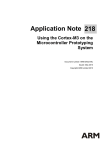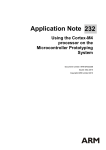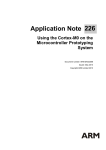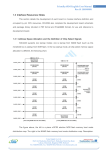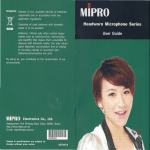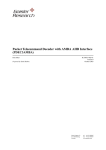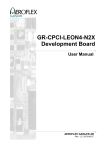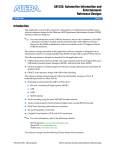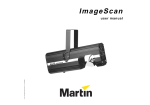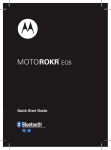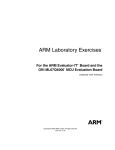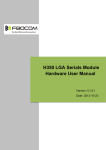Download Microcontroller Prototyping System - Using Cortex-M3
Transcript
Application Note 218 Using the Cortex-M3 on the Microcontroller Prototyping System Document number: ARM DAI0218A Issued: February 2009 Copyright ARM Limited 2009 Application Note 218 Using the Cortex-M3 on the Microcontroller Prototyping System Copyright © 2009 ARM Limited. All rights reserved. Release information The following changes have been made to this Application Note. Change history Date Issue Change February 2009 A First release Version controlled by Domino.Doc DS158-GENC-009371 2.3 References Document Issuer [1] User Manual for HMALC-AS3-52 Gleichmann Industries [2] HPE_Desk-Basic Online Help Gleichmann Industries [3] Altera Double Data Rate I/O Megafunctions User Guide Altera Corporation [4] The Definitive Guide to the ARM Cortex-M3 ISBN: 978-0-7506-8534-4 ARM Ltd (by Joseph Yiu) [5] PrimeCell® Synchronous Serial Port (PL022) Technical Reference Manual ARM Ltd. [6] Cortex™-M3 User Guide ARM DUI 0450A ARM Ltd. [7] CH7303 HDTV / DVI Transmitter (CH7303) Data Sheet Chrontel [8] ARM Dual-Timer Module (SP804) Technical Reference Manual ARM Ltd. [9] PrimeCell® Real Time Clock (PL031) Technical Reference Manual ARM Ltd. [10] ARM Watchdog Module (SP805) Technical Reference Manual ARM Ltd. [11] PrimeCell® UART (PL011) Technical Reference Manual (Revision: r1p5) ARM Ltd. [12] PrimeCell® Advanced Audio CODEC Interface (PL041) Technical Reference Manual ARM Ltd. [13] ARM PrimeCell Multimedia Card Interface (PL181) Technical Reference Manual ARM Ltd. [14] ISP1761 Hi-Speed Universal Serial Bus On-TheGo controller. Rev. 05 — 13 March 2008 Product data sheet. ST-NXP Wireless ii Copyright © 2009 ARM Limited. All rights reserved. Application Note 218 ARM DAI0218A Proprietary notice ARM, the ARM Powered logo, Thumb and StrongARM are registered trademarks of ARM Limited. The ARM logo, AMBA, Angel, ARMulator, EmbeddedICE, ModelGen, Multi-ICE, ARM7TDMI, ARM9TDMI, TDMI and STRONG are trademarks of ARM Limited. All other products, or services, mentioned herein may be trademarks of their respective owners. Confidentiality status This document is Open Access. This document has no restriction on distribution. Feedback on this Application Note If you have any comments on this Application Note, please send email to [email protected] giving: • the document title • the document number • the page number(s) to which your comments refer • an explanation of your comments. General suggestions for additions and improvements are also welcome. ARM web address http://www.arm.com Application Note 218 ARM DAI 0125A Copyright © 2006 ARM Limited. All rights reserved. iii Table of Contents 1 INTRODUCTION .................................................................................................................. 1 1.1 Purpose of this application note.................................................................................................................................... 1 1.2 Overview of the hardware platform............................................................................................................................. 1 2 GETTING STARTED............................................................................................................ 3 2.1 Switch settings ................................................................................................................................................................ 3 2.2 Software download to MPS........................................................................................................................................... 3 2.3 FPGA Image download to MPS.................................................................................................................................... 3 2.4 Clock control of MPS..................................................................................................................................................... 4 2.5 Rebuilding the DUT FPGA ........................................................................................................................................... 4 3 ARCHITECTURE ................................................................................................................. 5 3.1 Block Diagram................................................................................................................................................................ 5 3.2 Clock architecture........................................................................................................................................................ 10 3.3 Interrupt architecture ................................................................................................................................................. 13 3.4 Debug architecture....................................................................................................................................................... 13 3.5 Processor Implementation Architecture. ................................................................................................................... 13 4 4.1 5 HARDWARE DESCRIPTION ............................................................................................. 14 Top Level ...................................................................................................................................................................... 15 PROGRAMMER’S MODEL................................................................................................ 16 5.1 Memory map ................................................................................................................................................................ 16 5.2 CPU FPGA specific registers ...................................................................................................................................... 17 5.3 Customer DUT FPGA Specific Registers .................................................................................................................. 19 5.4 Boot operation .............................................................................................................................................................. 25 6 RTL..................................................................................................................................... 26 6.1 Directory structure ...................................................................................................................................................... 26 6.2 The fpga_dut Directory ............................................................................................................................................... 27 6.3 The peripherals Directory........................................................................................................................................... 27 iv Copyright © 2009 ARM Limited. All rights reserved. Application Note 218 ARM DAI0218A 6.4 7 7.1 Building the application note ...................................................................................................................................... 28 FUNCTIONAL TESTING.................................................................................................... 29 Self-test.......................................................................................................................................................................... 29 8 CLOCK FREQUENCY SETTINGS..................................................................................... 31 9 EXAMPLE SOFTWARE..................................................................................................... 32 9.1 Boot Monitor User Interface....................................................................................................................................... 32 9.2 Peripheral Support ...................................................................................................................................................... 36 9.3 Hardware Requirements ............................................................................................................................................. 38 9.4 Endianness.................................................................................................................................................................... 38 9.5 Multiprocessing............................................................................................................................................................ 39 9.6 System Boot .................................................................................................................................................................. 39 9.7 Platform Library Initialization................................................................................................................................... 39 9.8 Memory Management & Caches ................................................................................................................................ 39 9.9 Building the Firmware ................................................................................................................................................ 39 10 SIGNAL ASSIGNMENTS ................................................................................................ 40 10.1 Interface between the CPU and DUT FPGAs ........................................................................................................... 40 Application Note 218 ARM DAI 0125A Copyright © 2006 ARM Limited. All rights reserved. v Introduction 1 Introduction 1.1 Purpose of this application note This application note covers the operation of the Hpe®_midiv2 with the HM-ALC-AS3 from Gleichmann Electronics Research. It describes the contents of the FPGAs on the HMALC-AS3-52, the system interconnect, the clock structure, and specifics of the programmer’s model relevant to Customer FPGA’s operation. After reading this Application Note the user should be in a position to make changes to the customer FPGA design provided or introduce their own AHB based peripherals. 1.2 Overview of the hardware platform This application note is designed to work on the Microcontroller Prototyping System (as shown in Figure 1) fitted with the ARM Hpe®_module (as shown in Figure 2). This application note is intended for the processor FPGA to be installed with the ARM Cortex-M3 image. For further details on this system please see [1]. Figure 1: Microcontroller Prototyping System Application Note 218 ARM DAI0218A Copyright © 2009 ARM Limited. All rights reserved. 1 Introduction Figure 2: ARM HPE Module 2 Copyright © 2009 ARM Limited. All rights reserved. Application Note 218 ARM DAI0218A Getting started 2 Getting started The system comes pre-configured with an example design installed on the customer FPGA. The processor FPGA is configured and ready for use and the bootmonitor software is loaded into the system memory. Connect a serial cable to RS232-4 (UART port3 above the power connector) and use a terminal emulation program (e.g. HyperTerminal) configured as 38,400 baud, 8bit data, no parity, 1 stop bit and no flow control to talk to the MPS. Insert the power cable and turn on the PWR switch at the back. This will bring up the system and the bootmonitor will start execution. The character display will show the Firmware (F/W) and Hardware (H/W) versions of the system. This is also output to the serial port for display on the terminal if connected. The CPU LEDs (0 to 7) will cycle a lighted bit to show the bootmonitor is running. The three blue LEDs on the right will be lit to indicate that the system and FPGAs are configured with valid images. The four green Power LEDs will light to show all power supplies are functioning properly and within tolerance. If a FAN LED lights then the corresponding FPGA temperature is above the pre-defined limit (if fans are fitted then the fan for that FPGA will become operational). Pressing the recessed reset button on the front panel will perform a hardware reset and the system will restart as if it had been power cycled. 2.1 Switch settings The bootmonitor reads the processor switches 1-3 on power up and uses these to select the boot option. On delivery all the switches are set to ON and defaults to no boot script with auto detection of semihosting or UART port3 for console interface. SW1 ON OFF SW2 X X SW3 X X X ON ON X ON OFF X X OFF OFF ON OFF 2.2 Function Normal boot Run boot Script Note Use this as default This needs to be pre configured from the boot monitor command line Auto Select between UART port3 Detects semihosting supported debugger and Semihosting for Console Force UART port3 for Console Always use UART port3 regardless of semihosting support Reserved Do not use, undefined behaviour Reserved Do not use, undefined behaviour Software download to MPS The MPS comes with a Keil ULINK2 USB JTAG adaptor to allow download and programming of the Flash memory from µVision. The ULINK2 plugs into the 20way IDC connector at the back of the unit. Example software and projects are supplied for µVision. See the µVision documentation for details about how to compile and program the flash. If you do not use the JTAG download it is possible to transfer files and write them into flash using bootmonitor and the SD-card slot. It is possible to fit a SDCard or MMC into the SD-Card slot in the back and access it as a standard FAT16 8.3 filename device (long filenames are not supported and the maximum usable card size is 2GB). 2.3 FPGA Image download to MPS The HPE_Desk application (Windows based) from Gleichmann allows you to download new FPGA images for the DUT FPGA and updates from ARM for the CPU FPGA (when available). Please see the Hpe®_desk documentation for details on how to do this. Application Note 218 ARM DAI0218A Copyright © 2009 ARM Limited. All rights reserved. 3 Getting started 2.4 Clock control of MPS HPE_Desk allows you to select which clock sources are routed to which clock inputs of the FPGAs (clock factory) so you can change the operation frequency of both the CPU and DUT FPGAs. The Clocks to the clock factory are driven from the DUT and CPU FPGAs. the CPU FPGA clocks are fixed by the design and not alterable by the customer. The DUT FPGA clocks are alterable by the user by reconfiguring the PLL used to generate them. Refer to the Altera Stratix III documentation for details on configuration of the PLL. 2.5 Rebuilding the DUT FPGA To rebuild the DUT FPGA and configuring the MPS please see section 6.4. 4 Copyright © 2009 ARM Limited. All rights reserved. Application Note 218 ARM DAI0218A Architecture 3 Architecture This application note implements an AHB (AMBA 2.0) based system on the Microcontroller Prototyping System. This board contains two FPGAs on which the system is implemented: 3.1 • The CPU FPGA: One instance of the ARM Cortex M-3 processor with ETM, two memory controllers to operate interfaces to the noBLRAM and FLASH NOR RAM on the board, Touchscreen and I2C peripherals and a configuration register block. This FPGA has a dedicated interface to • The DUT FPGA: Containing an example system including timers, display drivers, an audio interface and an MCI/SD card interface. Block Diagram Figure 3 shows a conceptual block diagram of the system consisting of a CPU FPGA, a Customer DUT FPGA, peripherals and a Human Interface Block. Human Interface LED LED Push button LCD connector 1 2 DIP DIP 3 4 12V Power Supply DIP CPU L14 Customer DUT Stratix3 EP3SL50-C2 Stratix3 EP3SL50-C2 Reset To PC RES 126(182) 780 pin fpBGA 780 pin fpBGA ALTERA USB Blaster FCP 256 bit AES encrypted data stream for IP Clock Factory top FLASH Handler Hpe_child Connector Common Conf FLASH bottom DDR2 possible Hpe_module Connector Hpe_module Connector 31 L4 SSRAM 1Mb*36 SEmulator SSRAM 1Mb*36 L4 SEmulator JTAG 10 pin flat ribbon RS232 10 pin flat ribbon RS232 10 pin flat ribbon MICTOR FLASH 128 Mb*32 Figure 3: MPB System Block Diagram Application Note 218 ARM DAI0218A Copyright © 2009 ARM Limited. All rights reserved. 5 Architecture Implemented Not Implemented BaseBoard I/O I/O UART Switches LEDs Processorboard Ethernet Switches LEDs 7SEG Char LCD Ethernet I/O CAN Flexray Lin Trace/JTAG Trace Debug Interrupts CPU FPGA AHB Lite DUT FPGA Video SMB SMB SSRAM SSRAM NOR Video DMB SMB DDR USB Video I/F UARTS AC97 SD/MMC I2C SPI I/O MPB-M3 Block Diagram I/O Figure 4: Block diagram of the ARM Microcontroller Prototyping System. 6 Copyright © 2009 ARM Limited. All rights reserved. Application Note 218 ARM DAI0218A Architecture Bus architecture 3.1.1 Bus Architecture of CPU FPGA The CPU FPGA implements an AHB bus infrastructure. The bus matrix is used to give the processor access to the local FLASH and ZBT memory. An APB bus is used to connect PrimeCell APB peripherals. A separate AHB interconnect exists for access to the peripherals on the Customer DUT FPGA. External Device 0xE000_0000 0xE00F_FFFF M3 0x0000_0000 0x1FFF_FFFF I 0x2000_0000 0xDFFF_FFFF 0xE010_0000 0xFFFF_FFFF D Private Peripheral Bus DUT FPGA S CPU FPGA AHB Lite mux 0x1F00_0000 0x1F00_FFFF 0x1000_0000 0x103F_FFFF 0x1EFF_0000 0x1EFF_FFFF SMC1 RAM FPGA 0x0000_0000 0x03FF_FFFF 0x1040_0000 0x107F_FFFF 0x1800_0000 0x1BFF_FFFF 0x2000_0000 0xDFFF_FFFF 0xE010_0000 0xFFFF_FFFF AHB to APB APB Config registers I/O PADS PL011 (3) SMC0 PL022 (0) I2C (0) I/O PADS I/O PADS I/O PADS DUT FPGA CS0 SSRAM1 0x1000_0000 0x103F_FFFF And remaped to 0x0000_0000 CS1 SSRAM0 CS0 FLASH AHB Interface to DUT FPGA 0x1040_0000 0x107F_FFFF 0x0000_0000 And aliased to 0x03FF_FFFF 0x1800_0000 MPB-M3 Processor FPGA Figure 5: Bus Architecture of CPU FPGA 3.1.2 Bus Architecture of Customer DUT FPGA An additional AHB-Lite matrix is implemented in the DUT FPGA to give the processor access to all the AHB peripherals within the FPGA. An AHB to APB bridge gives access to the APB peripherals in the system. Application Note 218 ARM DAI0218A Copyright © 2009 ARM Limited. All rights reserved. 7 Architecture External Device AHB Interface from CPU FPGA 0x2000_0000 0xDFFF_FFFF 0xE010_0000 0xFFFF_FFFF Private Peripheral Bus I/O PADS CPU FPGA DUT FPGA I/O PADS CPU FPGA Video AHB Lite mux 0x4000_0000 0x5FFF_FFFF Video config reg 0xA000_0000 0xDFFF_FFFF 0x6000_0000 0x9FFF_FFFF 0xE010_0000 0xFFFF_FFFF Video Ethernet Ethernet Reserved LIN Reserved CAN Reserved Flexray DMC (DDR I/II) User Supplied SMC I/O PADS I/O PADS System AHB to APB I/O PADS DMC config reg DDR I/II SMC config reg SRAM/NOR DUT Char LCD Character LCD I2C (1) AACI/AC97 PL011 (2) UART (2) PL011 (1) UART (1) PL011 (0) UART (0) DUT Config Regs 0xA000_0000 0xA03F_FFFF Switches/LEDs config Timer[3:2] SP804 (0) Timer[1:0] SP805 (0) USB SD/MMC SP804 (1) PL031 0x6000_0000 0x9FFF_FFFF I2C PL041 PL181 External memory RTC WatchDog Figure 6: Bus Architecture of Customer DUT FPGA 8 Copyright © 2009 ARM Limited. All rights reserved. Application Note 218 ARM DAI0218A Architecture 3.1.3 CPU FPGA functionality Bus Infrastructure components 32-bit AHB 2x1 Bus Mux Provides the bulk of the interconnect structure. It handles the contention between the Instruction and Data AHB busses of the processor when they access the local memory and peripherals. AHB Decoder This block implements the memory map for the CPU FPGA bus structure. AHB Data Mux This block connects the Bus matrix to the AHB and APB peripherals. It handles the returning data and responses from the peripherals AHB to APB Bridge The bridge contains the muxing and decoding scheme for the bus, allowing the APB peripherals to be connected. Memory ZBT RAM Controller Controller for a ZBT (zero-bus-turnaround) RAM. Allows the CPU access to the local fast RAM. Flash RAM Controller Controller for Samsung Flash NOR RAM. Allows CPU access to the local Flash RAM. Peripherals Serial Bus I/F Controls the detection and configuration of the DVI transmitter IC. Sync Serial Port ARM Primecell PL022 Synchronous Serial Port. Used to interface to a touch screen controller. System Regs Set of registers for configuration and control of the CPU FPGA. For a complete list of the functionality of these registers, refer to section 5.2.1 of this application note. UART 3 3.1.4 ARM PrimeCell PL011 Universal Asynchronous ReceiverTransmitter interfaces (RS-232 serial). Used by the Boot Monitor as default. Customer DUT FPGA functionality Bus Infrastructure components Application Note 218 ARM DAI0218A AHB Decoder This block implements the memory map for the DUT FPGA bus structure. AHB Data Mux This block connects the Bus matrix to the AHB peripherals and the APB bridge. It handles the returning data and responses from the peripherals AHB to APB Bridge The bridge contains the muxing and decoding scheme for the bus, allowing the APB peripherals to be connected. APB Decoder This block implements the memory map for the DUT FPGA APB bus structure. This decoder assumes that the AHB Copyright © 2009 ARM Limited. All rights reserved. 9 Architecture decoder has selected the APB region of the memory map. Peripherals 3.2 Serial Bus I/F Used as an ADC/DAC interface. AACI ARM Primecell PL041 Advanced Audio Codec Interface. Character LCD Controller for the Character LCD. Provides a memorymapped register interface to the display. MCI ARM Primecell PL181 Multimedia Card Interface. Real Time Clock ARM Primecell PL031 Real Time Clock module. Real time refers to total time from an event, and not actual real world time. System Regs Set of registers for configuration and control of the DUT FPGA. For a complete list of the functionality of these registers, refer to section 5.3.1 of this application note. Timers 0-1 ARM ADK component SP804 UARTs 0-2 ARM PrimeCell PL011 Universal Asynchronous ReceiverTransmitter interfaces (RS-232 serial). Watchdog ARM ADK component SP805 is the watchdog controller. It allows for the generation of an interrupt or reset after a defined time to prevent against system lockup/failure. Clock architecture The clock factory is a Gleichmann specific implementation and is treated as a blackbox with configuration performed by their software application [2] and the Altera Quartus II tools. Figure 7 shows the clock and reset architecture for the system. 10 Copyright © 2009 ARM Limited. All rights reserved. Application Note 218 ARM DAI0218A Architecture BaseBoard MCB0_1/33/65/66 CLK0/1/Ext/MOD Processorboard CPU_PLL_R2/L2_CLKOUT0 DUT_PLL_R2_CLKOUT0 CPU_PLL_T1/B1_CLKOUT3 DUT_PLL_T1/B1_CLKOUT3 MCB0_B58/PWR_RESET# MCB0_B60/USER_RESET# 100MHz Osc Clock Factory MCB0_B62/HPE_RESET# CLK5p/15p CLK4p/13p CLK100M CLK1p/10p (matched lengths) DUT_PLL_T1/B1_CLKOUT3 MCB0_B34/B2 PLL PLL L14_CPUCLK_Diff L14_DUTCLK_Diff CPU FPGA DUT FPGA USER_RESET# HPE_RESET# Figure 7: MPB-M3 Clock and Reset Architecture 3.2.1 Clock Routing Name CLK100M CLK0 CLK1 EXT CLK5p CLK15p CLK1p CLK10p CLK4p CLK13p DUT_PLL_T1_CLKOUT3 DUT_PLL_B1_CLKOUT3 DUT_PLL_R2_CLKOUT0 CPU_PLL_L2_CLKOUT0 CPU_PLL_R2_CLKOUT0 CPU_PLL_B2_CLKOUT3 CPU_PLL_T2_CLKOUT3 L14_CPUCLK_Diff L14_DUTCLK_Diff Freq (Hz) Source Destination 100M Osc CF,DUT,CPU BB CF BB CF BB CF CF CPU CF CPU HCLK CF CPU,DUT 25M CF CPU,DUT 25.175M 12.288M 25M 50M 25M 0M 0M 0M 0M CF CF DUT DUT DUT CPU CPU CPU CPU CPU DUT DUT DUT CF,CPU,MCB0 CF,CPU,MCB0 CF CF CF CF CF DUT CPU Note Buffered output to DUT and CPU Oscillator module on Baseboard Oscillator module on Baseboard External SMB clock input on Baseboard Direct connection to CPU only Direct connection to CPU only Buffered match lengths to DUT & CPU (HCLK) Buffered match lengths to DUT & CPU (CLK25MHz) Direct connection to DUT only Direct connection to DUT only Buffered FPGA output from internal PLL Buffered FPGA output from internal PLL Direct FPGA output from internal PLL Direct FPGA output from internal PLL Direct FPGA output from internal PLL Direct FPGA output from internal PLL Direct FPGA output from internal PLL Direct FPGA differential output for L14 interface Direct FPGA differential output for L14 interface Table 1: Clock Routing Application Note 218 ARM DAI0218A Copyright © 2009 ARM Limited. All rights reserved. 11 Architecture 3.2.2 Reset Routing Name PWR_RESET# USER_RESET# HPE_RESET# Source BB All CF Destination CF CF,CPU,DUT BB, DUT Note O/D output from supply monitor (internal use) Push button on Processor board O/D Driven by USER_RESET# and PWR_RESET# Table 2: Reset Routing Notes: BB: BaseBoard CF: Clock Factory CPU: CPU FPGA DUT: DUT FPGA OSC: Crystal Oscillator module. The System only uses the USER_RESET# signal and this drives all internal resets (nPOR, nHRESET etc). The design ignores PWR_RESET# and HPE_RESET#. The CPU FPGA drives the nHRESET signal between the CPU and DUT FPGA to create a synchronous reset (with respect to HCLK) in the DUT FPGA. The DUT FPGA uses this to resynchronise resets to all other clock domains within the FPGA. 3.2.3 Clock and Reset Destinations Device CPU AHB/APB infrastructure SMC (ZBT & NOR) UART SPI I2C VIDEO AC97 SD/MMC Character LCD 7SEG Display Timer Real Time Clock Watch Dog USB Static Memory Clock Freq HCLK HCLK HCLK 25MHz 25MHz HCLK 23.75MHz 12.288MHz 25MHz HCLK HCLK 1MHz 1Hz 1Hz HCLK HCLK Clock ref CLK1p CLK1p CLK1p CLK10p CLK10p CLK1p CLK4p CLK13p CLK10p CLK1p CLK1p CLK10p CLK10p CLK10p CLK1p CLK1p Reset ref HRESETn HRESETn HRESETn HRESETn HRESETn HRESETn HRESETn HRESETn HRESETn HRESETn HRESETn HRESETn HRESETn HRESETn HRESETn HRESETn Note Runs as CPU frequency CPU FPGA memory controllers and I/F to USB IC PL011 PL022 DS702 Video/LCD controller pixel clock PL041 PL181 DS700 TBD SP804 PL031 SP805 External IC ISP1761 Memory controller on DUT FPGA Table 3: Clock and Reset Destinations All the peripherals that have an AHB or APB interface have that interface running at CLK1p. CLK100M is used to derive all peripheral clocks where appropriate since this is a non variable clock and ideal for timers, watchdogs etc. The Reset column refers to the reset signal that is re-synchronised to the respective clock domain. 12 Copyright © 2009 ARM Limited. All rights reserved. Application Note 218 ARM DAI0218A Architecture 3.3 Interrupt architecture The interrupt controller for the Cortex-M3 implementation is integrated into the processor, but the mapping of peripheral to interrupt is irrespective of the controller implementation. Figure 8 describes which interrupt is driven by each peripheral. Cortex-M3 has an NMI input so INT[0] from the following interrupt table (driven by the watchdog timer peripheral) is also routed to NMI on the Cortex-M3 processor. External Device [31] PL022 [30] [29] [28] SPI touchscreen [63] [95] PL011 (3) UART (3) [62] [94] Reserved Ext touchscreen [61] [93] Reserved I2C DVI [60] [92] [59] [91] [58] [90] [57] [89] [24] [56] [88] [23] [55] [87] [54] [86] [53] [85] [52] [84] Private Peripheral Bus DUT FPGA [27] CPU FPGA [26] [25] Reserved [22] [21] Reserved [20] [19] Reserved I2C ADC/DAC [51] [83] [18] Reserved LIN [50] [82] [17] Reserved CAN [49] [16] Reserved Flexray [48] [15] Char LCD Character LCD [47] [79] [14] USB USB HC [46] [78] [13] USB USB DC [45] [77] [12] Ethernet Ethernet [44] [76] [11] PL111 CLCD combined Int [43] [75] [10] PL041 AACI/AC97 [42] [74] [09] Reserved [41] [73] [08] PL011 (2) UART (2) [40] [72] [07] PL011 (1) UART (1) [39] [71] [06] PL011 (0) UART (0) [38] [70] [05] PL181 MCIb [37] [69] [04] PL181 MCIa [36] [68] [03] SP804 (1) Timer[3:2] [35] [67] [02] SP804 (0) Timer[1:0] [34] [66] [01] PL031 RTC [33] [65] [00] SP805 (0) WatchDog [32] [64] NMI SP805 (0) WatchDog [81] [80] Reserved Reserved MPB-M3 Interrupt Figure 8: Interrupt Allocation Table This interrupt structure is in addition to the 16 internal CPU interrupts on the Cortex-M3. 3.4 Debug architecture The example design provided with this Application Note is based on a simple JTAG debug architecture. For the JTAG chain routing please refer to the Module User Guide [1]. The Cortex-M3 implementation contains an ETM which is connected directly to the trace MICTOR connector on the FPGA Module. 3.5 Processor Implementation Architecture. The Cortex-M3 processor has been implemented with the following functionality. Application Note 218 ARM DAI0218A Function Implemented MPU Yes Interrupts yes Details 32 external IRQ’s (Error! Bookmark not Copyright © 2009 ARM Limited. All rights reserved. 13 Architecture defined.) Priority Yes 3 bits 8 levels Trace yes Full debug including data matching JTAG & SWD Yes Both JTAG and Single wire debug present Clock gating No No architectural clock gating implemented in design All registers reset No Not all registers are reset after system reset Internal observability No No internal observability implemented WIC No No WIC implemented SYSTICK Yes 100kHz reference clock implemented with divider to 10ms. Power Management No The Sleep modes do not perform any clock stopping, but will allow the WFI type functionality. Multiprocessor Communication No No support for multiprocessor communication is implemented. Table 4: Cortex-M3 Configuration 14 Copyright © 2009 ARM Limited. All rights reserved. Application Note 218 ARM DAI0218A Hardware description 4 Hardware description 4.1 Top Level The top level of the DUT FGPA is fpga_dut.v This top level: • Handles all the static tie offs, • Maps the internal design signals to the board connections, • Includes/calls the header file which contains the configuration information for the example system. • Instances any special IO cells the design requires (e.g., the DDR registers for the Video connections). The top level module instantiates the dut_logic,v module which in turn instances all the blocks in the example system and defines the interconnect between them. 4.1.1 Configuring the Example System As an example of how to prototype a system too large for the Customer System FPGA, the definitions file (fpga_dut_defs.v) contains four defines which allow the system to be built without significant portions of the design to reduce size or improve performance. By default, the audio codec and MMC/SD card interfaces are included but by uncommenting or commenting out the following lines, the system configuration can be altered. Define Effect `define INCLUDE_CLCD This includes the Colour LCD and Video controller block (user supplied). Without this define, the pixel clock is not driven and the data and control lines are tied to ‘0’. Which means that the video bus will not drive any data or clock at all. Implement the VGA Pattern Generator 640x480 if no CLCD present Implement the VGA Pattern Generator 800x600 if no CLCD present Implement the VGA Pattern Generator 1024x768 if no CLCD present This includes the Primecell PL041 (Audio Codec interface). This includes the Primecell PL181 (MMC/SD interface). This includes the DDR memory interface (user supplied). If these components are not included then the video and LCD controller does not have any route to memory so the address out of the video and LCD controller block is connected to the read data bus giving a static image on any screen attached to that interface. `define `define `define `define `define `define VGA SVGA XVGA INCLUDE_AACI INCLUDE_MCI INCLUDE_DMC Table 5: System Configuration Application Note 218 ARM DAI0218A Copyright © 2009 ARM Limited. All rights reserved. 15 Programmer’s model 5 Programmer’s model 5.1 Memory map 5.1.1 CPU FPGA External Device M3 memory area function 0x10000_0000 Private Peripheral Bus System Bus 0xF000_0000 0xE010_0000 System Bus 0xE000_0000 Int M3 PPB DUT FPGA CPU FPGA Ext Periph non Exec 0xD000_0000 Ext Periph non Exec 0xC000_0000 Ext Periph non Exec 0xB000_0000 Ext Periph non Exec 0xA000_0000 0x2000_0000 Ext RAM Exec 0x9000_0000 Reserved ≈ 0x2000_0000 Ext RAM Exec 0x8000_0000 Config Regs 0x1F00_0000 Config Regs RAM FPGA (64k) 0x1EFF_0000 Ext RAM Exec 0x7000_0000 ≈ Reserved 0x1C00_0000 ≈ 0x1F00_4000 ≈ Reserved 0x6000_0000 Periph non Exec ≈ Flash (64M alias) ≈ 0x1F00_0FFC ≈ Reserved ≈ ≈ PL022 (TouchScrn) 0x4000_0000 ≈ Reserved RAM B (4M) RAM B (4M) 0x1000_0000 RAM A (4M) RAM A (4M) ALIAS = 1 ALIAS = 0 Int RAM B Exec 0x3000_0000 ≈ ≈ I2C (DVI) 0x1F00_2000 Reserved (SMC) 0x1F00_1000 Reserved (SMC) 0x1F00_0010 TS Status 0x1F00_0000 CPU Sys Regs 0x1F00_000C CPU LEDs 0x1F00_0008 CPU Switches 0x1F00_0004 Remap/Alias 0x1F00_0000 System ID ≈ 0x1080_0000 0x1040_0000 Reserved ≈ 0x1F00_3000 0x1800_0000 Periph non Exec 0x1F00_1000 PL011 (3) 0x1F00_5000 RAM FPGA (64k) ≈ Ext RAM Exec 0x5000_0000 ≈ 0x1F00_6000 0x1F00_0014 Int RAM A Exec 0x2000_0000 0x1000_0000 Int ROM Exec 0x1000_0000 ≈ Int ROM Exec Reserved ≈ ≈ Reserved ≈ 0x0000_0000 0x0400_0000 Flash (60M) 0x0040_0000 0x0000_0000 MPB-M3 Processor FPGA Flash (64M) RAM A (4M) REMAP = 1 REMAP = 0 Figure 9: CPU FPGA memory map 16 Copyright © 2009 ARM Limited. All rights reserved. Application Note 218 ARM DAI0218A Programmer’s model 5.1.2 DUT FPGA External Device M3 memory area function 0x10000_0000 0xC000_0000 Private Peripheral Bus System Bus 0xF000_0000 0xE010_0000 System Bus 0xE000_0000 Int M3 PPB DUT FPGA 0xA400_0000 ≈ ≈ SMC Reserved 0xA3FF_0000 CPU FPGA Ext Periph non Exec ≈ 0xD000_0000 Reserved ≈ 0xA400_0000 Ext Periph non Exec 0xC000_0000 0xA000_0000 SMC Peripheral 0 0xA002_0000 USB (128kB) 0xA000_0000 Ext Periph non Exec 0xB000_0000 0x5000_0000 Ext Periph non Exec 0xA000_0000 0x4FFF_0000 Video 0x4FFE_0000 Ethernet DMC (DDRII) Ext RAM Exec 0x9000_0000 0x4FFD_0000 LIN 0x4FFC_0000 CAN 0x4FFB_0000 Flexray Ext RAM Exec 0x8000_0000 0x4FFA_0000 Ext RAM Exec ≈ 0x7000_0000 Reserved ≈ Reserved ≈ 0x4FF0_0000 Ext RAM Exec 16x 64kB AHB peripherals 0x6000_0000 0x4001_0000 0x4000_F000 ≈ Periph non Exec 0x5000_0000 0x4000_E000 16x 4kB APB peripherals Reserved (SMC cfg) 0x4000_C000 DUT Char LCD 0x4000_B000 I2C (ADCDAC) Int RAM B Exec 0x3000_0000 ≈ Reserved PL041 Reserved 0x4000_8000 PL011 (2) 0x4000_4018 Counter100Hz 0x4000_7000 PL011 (1) 0x4000_4014 Counter25MHz 0x4000_6000 PL011 (0) 0x4000_4010 DUT 7Seg Display 0x4000_5000 PL181 0x4000_400C DUT LEDs 0x4000_4000 DUT Sys Regs 0x4000_4008 DUT Switches 0x4000_3000 SP804 (1) 0x4000_4004 Periph Cfg 0x4000_2000 SP804 (0) 0x4000_4000 System ID 0x4000_1000 PL031 0x4000_0000 SP805 (0) Int ROM Exec 0x0000_0000 0x4000_5000 0x4000_9000 Int ROM Exec 0x1000_0000 ≈ 0x4000_A000 Int RAM A Exec 0x2000_0000 ≈ 0x4000_D000 Periph non Exec 0x4000_0000 Reserved (DMC cfg) ≈ 0x4000_401C MPB-M3 DUT FPGA Figure 10: DUT FPGA memory map 5.2 CPU FPGA specific registers 5.2.1 System Registers The system registers are based at address 0x1F00_0000. Register SYS_ID SYS_MEMCFG SYS_SW SYS_LED SYS_TS Offset ‘h0000 ‘h0004 ‘h0008 ‘h000C ‘h0010 Access RO RW RO RW RO Reset ‘h102304xx ‘h00000000 ‘h000000xx ‘h00000000 ‘h00000000 Note Board and FPGA identifier. Controls memory Remap and Alias Indicates user switch settings Sets LED outputs. TouchScreen register 5.2.1.1 ID register (SYS_ID) Name Bits REV 31:28 BOARD 27:16 VARIANT 15:12 ARCH 11:8 BUILD 7:0 Access RO RO RO RO RO Reset ‘h1 ‘h023 ‘h0 ‘h4 ‘hxx Note Board Revision B HBI Board number Build Variant of board Bus Architecture (4 AHB, 5 AXI) FPGA build Application Note 218 ARM DAI0218A Copyright © 2009 ARM Limited. All rights reserved. 17 Programmer’s model 5.2.1.2 Memory Configuration (SYS_MEMCFG) Name Bits Access Power On Reset Reserved 31:3 SWDPEN 2 RW ‘b0 ALIAS REMAP 1 0 RW RW ‘b1 ‘b0 Note Single Wire Debug Port Enable. 1 is SWD 0 JTAG. Not used in Cortex-M3 implementation as this autodetects serial or JTAG. Alias FLASH. 1 is Aliased on 0 Aliased off Remap SSRAM. 1 is Remap on 0 Remap off Default memory mapping is Flash Aliased and SSRAM not remapped. The register is reset at power on to this state, but any debug reset or system reset will not change the values stored. This allows the SRAM to be programmed placed and address 0x0000_0000 and execute after generating a system reset. 5.2.1.3 Switches (SYS_SW) Name Bits Reserved 31:8 USER_SWITCH 7:0 5.2.1.4 LEDs (SYS_LED) Name Bits Reserved 31:8 LED 7:0 5.2.1.5 TouchScreen (SYS_TS) Name Bits Reserved 31:2 TS_INT 1 TS_BUSY 0 5.2.2 Access Reset Note RO Always returns value of user switches ‘h-- Access Reset Note RW Returns value in register. 1 is LED on 0 LED off ‘h00 Access Reset Note RO RO External Interrupt from Touchscreen External Busy signal from Touchscreen ‘b‘b- Video (I2C for DVI) The DS702 peripheral is used for the interface and implements a bit banging method for the I2C interface. The base address for this interface is 0x1F00_3000. Register SB_CONTROL SB_CONTROLS SB_CONTROLC Offset ‘h0000 ‘h0000 ‘h0004 Access R W WO Reset ‘b0‘b00 ‘b00 5.2.2.1 SB Status register (SB_CONTROL) Name Bits Access Reset Reserved 31:2 SB_SDA 1 RO ‘b0 SB_SCL 0 RO ‘b0 5.2.2.2 SB Set register (SB_CONTROLS) Name Bits Access Reset Reserved 31:2 SB_nSDAOUTEN 1 W ‘b0 SB_SCLOUT 0 W ‘b0 5.2.2.3 SB Clear register (SB_CONTROLC) Name Bits Access Reset Reserved 31:2 18 Note Status Register of I/O signals Set Output bits Clear Output bits Note Level of SDA signal Level of SCL signal Note Sets SDA line when 1 Sets SCL line when 1 Note Copyright © 2009 ARM Limited. All rights reserved. Application Note 218 ARM DAI0218A Programmer’s model SB_nSDAOUTEN SB_SCLOUT 1 0 W W ‘b0 ‘b0 Clears SDA line when 1 Clears SCL line when 1 5.2.2.4 Basic Timing The basic I2C timing diagram is shown below. The ACK is a returned value from the target device (responding to a data burst being received). CB_SDA MSB LSB ACK CB_SCL Stop Start Figure 11: I2C Timing Diagram 5.2.3 Touchscreen The Primecell PL022 is used to drive the touchscreen interface. This interface has a base address of 0x1F00_4000. [5] 5.3 Customer DUT FPGA Specific Registers 5.3.1 System Registers The DUT specific registers are mapped to a 16KB area at 0x4000_4000. The addresses in this section are all relative to this base address. Register SYS_ID SYS_PERCFG SYS_SW SYS_LED SYS_7SEG SYS_CNT25MHz SYS_CNT100Hz Offset ‘h0000 ‘h0004 ‘h0008 ‘h000C ‘h0010 ‘h0014 ‘h0018 Access RO RW RO RW RW RO RO Reset ‘h102304xx ‘h00000000 ‘h000000xx ‘h00000000 ‘h00000000 ‘h00000000 ‘h00000000 Note Board and FPGA identifier. Peripheral control signals Indicates user switch settings Sets LED outputs. Sets LED outputs. Free running counter incrementing at 25MHz Free running counter incrementing at 100Hz 5.3.1.1 ID register (SYS_ID) Name Bits REV 31:28 BOARD 27:16 VARIANT 15:12 ARCH 11:8 BUILD 7:0 Access RO RO RO RO RO Reset ‘h1 ‘h023 ‘h0 ‘h4 ‘hxx Note Board Revision B HBI Board number Build Variant of board Bus Architecture (4 AHB) FPGA build 5.3.1.2 Peripheral configuration (SYS_PERCFG) Name Bits Access Reset Reserved 31:12 USB_FORCE_SLOW 11 RW ‘b0 HUMI_MODE 10:8 RW ‘b000 USB_HC_WAKE 7 RO ‘bUSB_DC_WAKE 6 RO ‘bReserved Reserved Reserved Application Note 218 ARM DAI0218A 5 4 3 RO RW RW Note Forces the USB interface to operate slowly Operation mode of HUMI multiplexer (see table) Status of USB Host Controller Wake/Suspend signal Status of USB Device Controller Wake/Suspend signal ‘b0 ‘b0 ‘b0 Copyright © 2009 ARM Limited. All rights reserved. 19 Programmer’s model Reserved WPROT CARDIN 2 1 0 RO RO RO ‘b0 ‘b0 ‘b0 Status of MCI WPROT bit, 1 write protected Status of MCI card Present, 1 card inserted The HUMI Mode bits define how the scheduler selects the different display components on the system. This can be used for system debug. Mode Scheduler LEDs 7Segment 0 7Segment 1 7Segment 2 7Segment 3 Character LCD Reserved Bit value 000 001 010 011 100 101 110 111 5.3.1.3 Switches (SYS_SW) Name Bits Reserved 31:8 USER_BUT[3:0] 7:4 USER_SW[3:0] 3:0 5.3.1.4 LED’s (SYS_LED) Name Bits Reserved 31:8 LED 7:0 Note Round robin schedule to all HUMI devices HUMI LEDs only output HUMI 7Segment display 0 only output HUMI 7Segment display 1 only output HUMI 7Segment display 2 only output HUMI 7Segment display 3 only output HUMI character LCD only output Reserved - Do Not Use Access Reset Note RO RO Always returns value of user buttons Always returns value of user switches ‘h‘h- Access Reset Note RW Returns value in register. 1 is LED on 0 LED off ‘h00 5.3.1.5 20 Copyright © 2009 ARM Limited. All rights reserved. Application Note 218 ARM DAI0218A Programmer’s model 5.3.1.6 Display output (SYS_7SEG) Name Bits Access DISP3 31:24 RW DISP2 23:16 RW DISP1 15:8 RW DISP0 7:0 RW Reset ‘h00 ‘h00 ‘h00 ‘h00 Note Segments for display 3 Segments for display 2 Segments for display 1 Segments for display 0 Disp3 Disp2 Disp1 Disp0 A A A A F B F G E B F G C E D P D B F G C D E D P B G C D E D P C D D P Figure 12: 7 Segment Display Segment Identification 5.3.1.6.1 The bit relationship to segment. Name DP G F E D C B A Bit 7 6 5 4 3 2 1 0 Note 1 is Decimal Point on, 0 is Decimal Point off. 1 is segment on, 0 is segment off. 1 is segment on, 0 is segment off. 1 is segment on, 0 is segment off. 1 is segment on, 0 is segment off. 1 is segment on, 0 is segment off. 1 is segment on, 0 is segment off. 1 is segment on, 0 is segment off. 5.3.1.7 25MHz Counter (SYS_CNT25MHz) Name Bits Access Reset Count25MHz 31:0 RO ‘h00000000 Note Free running counter from 25MHz clock 5.3.1.8 100Hz Counter (SYS_CNT100Hz) Name Bits Access Reset Count100Hz 31:0 RO ‘h00000000 Note Free running counter from 100Hz clock 5.3.2 ADC/DAC (I2C) The DS702 peripheral is used for the interface and implements a bit banging method for the I2C interface. The base address for this peripheral is 0x4000_B000. Please see section 5.2.2 for details of registers. Application Note 218 ARM DAI0218A Copyright © 2009 ARM Limited. All rights reserved. 21 Programmer’s model 5.3.3 Character LCD The Character display component is the DS700 and interfaces to the industry standard Hitachi HD44780 controller. It uses 11 signals 8 data, 1 strobe (E), read/write (RnW) and Register/data select (RS). Note: the interface can be a 4-bit or 8-bit interface. For this application it is in 8-bit mode. Note: When the display is used with a 4-bit interface an 8-bit value has to be written/read as two consecutive nibbles, writing/reading bits [7:4] first into register bits [7:4], then writing/reading bits [3:0] into register bits [7:4]. Register Offset Access Reset Note CHAR_COM ‘h0000 RW ‘h00000000 CHAR_DAT ‘h0004 RW ‘h00000000 CHAR_RD ‘h0008 RO ‘h00000000 CHAR_RAW ‘h000C RW ‘h00000000 CHAR_MASK ‘h0010 RW ‘h00000000 CHAR_STAT ‘h0014 RO ‘h00000000 A write will write to the display controller command register. A read will initiate a status register access (returns value later in CHAR-RD). A write will write to the display controller data register. A read will initiate a data register access (returns value later in CHAR-RD). Contains data from last CHAR_COM or CHAR_DAT read when CHAR_RAW[8] is set. Reading bit 8 indicates if access is complete. Writing 0 to bit 8 clears bit. Set bit 0 to 1 will generate interrupt when access completes. Returns status of Access Complete ANDed with CHAR MASK. 22 Copyright © 2009 ARM Limited. All rights reserved. Application Note 218 ARM DAI0218A Programmer’s model 5.3.3.1 Character Command Register (CHAR_COM) Name Reserved COMMAND Bits 31:8 7:0 Access Reset RW ‘h00000000 RW ‘h00000000 Note A write will write to the display controller command register. A read will initiate a status register access (returns value later in CHAR_RAW and CHAR-RD). 5.3.3.2 Character Data Register (CHAR_DAT) Name Reserved DATA Bits 31:8 7:0 Access Reset RW ‘h00000000 RW ‘h00000000 Note A write will write to the display controller data register. A read will initiate a data register access (returns value later in CHAR_RAW and CHAR-RD 5.3.3.3 Character RD Register (CHAR_RD) Name Reserved READ Bits 31:8 7:0 Access Reset RO ‘h00000000 RO ‘h00000000 Note Contains data from last CHAR_COM or CHAR_DAT read when DONE is set. 5.3.3.4 Character Command Register (CHAR_RAW) Name Reserved DONE Bits 31:9 8 Access Reset RW ‘h0000000 RW ‘b0 Reserved 7:0 RW Note Reading indicates if access is complete. Writing 0 clears bit. ‘h00 Note: If a transaction is attempted before DONE is asserted (CHAR_RAW register) by the controller then it maybe ignored and the command/data transfer could be lost. Once DONE is asserted it can be cleared and a transaction started. 5.3.3.5 Character Interrupt Mask Register (CHAR_MASK) Name Reserved MASKINT Bits 31:1 0 Access Reset RW ‘h00000000 RW ‘b0 Note Set to 1 will generate interrupt when access completes (CHAR_DONE set) 5.3.3.6 Character Status Register (CHAR_STAT) Name Reserved Application Note 218 ARM DAI0218A Bits 31:1 Access Reset RW ‘h00000000 Note Copyright © 2009 ARM Limited. All rights reserved. 23 Programmer’s model STATINT 5.3.4 0 RW ‘b0 Returns status of CHAR_DONE ANDed with CHAR_MASKINT. Video This is a user supplied component with basic interfaces brought into the DUT FPGA to enable implementation. The DVI-I controller device [7] includes an I2C (DS702) serial bus for configuration this is implemented in the CPU FPGA (see section 5.2.2 for details of registers). The Datasheet [7] covers the data format and process for configuration. The example clock source for the video pixel clock is derived from the PLL in the DUT FPGA and drives a clock input of the DUT FPGA (CLK4p) via the clock factory. The clock source isset by the HPE_Desk application on the PC and the frequency is determined by the PLL implemented in the DUT FPGA. Note: though the interface to the Video and LCD displays is driven by the processor FPGA, the peripheral is in the Customer DUT FPGA and the video/LCD signals are driven across the interconnect between the two FPGAs (see section 10.1). The signals from the CLCD are mapped to the video signals as follows. PL111 [6] Name CLCP CLPOWER CLLP CLFP CLAC CLLE CLD[19:16] CLD[15:8] CLD[7:0] CLD[23:20] CLD[23:0] CLD[7:2] CLD[15:10] CLD[23:18] - LCD name LCD_R_SHFCLK LCD_R_HSYNC LCD_R_VSYNC LCD_R_M_DE LCD_TTL_R[5:0] LCD_TTL_G[5:0] LCD_TTL_B[5:0] - Video Name VIDEOCLK VIDEOHSYNC VIDEOVSYNC VIDEODE VIDEO[11:8] VIDEO[7:0] VIDEO[11:4] VIDEO[3:0] VIDEO[11:0] VIDEORESET# VIDEOHPINT VIDEOMODE VIDEO_I2C_SC L VIDEO_I2C_SD A - LCD_BLON LCD_VDON Note Pixel Clock Not Used Horizontal Sync Vertical Sync Data Enable Not Used Green Data DDR encoded rising edge Blue Data DDR encoded rising edge Red Data DDR encoded falling edge Green Data DDR encoded falling edge RGB colour Data DDR encoded falling edge Red Data MSB’s Green Data MSB’s Blue Data MSB’s Reset synchronised to pixel clock Hot Plug interrupt (Not Used) Video Mode GPIO pin of video chip (Not Used) Video Chip configuration bus Video Chip configuration bus Back Light On (output tied to 1) LCD Power On (output tied to 1) Table 6: Video and LCD Connections For further data on the video encoding see the Datasheet for Chrontel CH7303A device [7]. 5.3.5 Timer The SP804 ADK component is used for the timers. See the TRM for details about its functionality [8]. The Timer clock is set at 1MHz and is derived from the 100MHz clock. The combined interrupt is used so each SP804 implementation only has 1 interrupt output (see section 3.3). 24 Copyright © 2009 ARM Limited. All rights reserved. Application Note 218 ARM DAI0218A Programmer’s model 5.3.6 RTC The PL031 PrimeCell is used as the RTC. See the TRM for details about its functionality[9]. The RTC clock is feed from the RTCCLK signal and is 1Hz and is derived from the 100MHz clock. 5.3.7 WatchDog The SP805 ADK component is used for the watchdog. See the TRM for details about its functionality[10]. The clock is set at 1Hz and is derived from the 100MHz clock. 5.3.8 Dynamic Memory Controller This is a user supplied component with basic interfaces brought into the DUT FPGA to enable implementation. 5.3.9 Static Memory Controller The Static memory interface implemented in the design is specifically to allow communication to the ISP1761 USB device [14]. Configuration and use of this is outside the scope of this Application Note 5.3.10 UARTs The PL011 PrimeCell is used as the UART. See the TRM for details about its functionality [11]. The clock source is divided down and is derived from the 100MHz clock. 5.3.11 Audio (AACI/AC97) The PL041 PrimeCell is used as the AACI. See the TRM for details about its functionality [12]. The AACI is a modification of the PrimeCell with increased FIFO depth to help improve transfer performance in FPGA. The clock source is derived from the baseboard and drives a clock input of the DUT FPGA (CLK13p). The FPGA can also drive the AC_EXT_CLK to set the clock, but this option is not implemented. 5.3.12 MMC/SD (MMCI) The PL181 PrimeCell is used as the MMC/SD card controller. See the TRM for details about its functionality [13]. The MMCI uses the bits in the system registers to identify the write protection and card inserted status (see section 5.3.1 for details). 5.4 Boot operation This system should normally boot from the board NOR Flash (the default configuration switches in the up position). The NOR Flash is preprogrammed with the boot monitor. The user can also program custom boot software in NOR Flash, but note that any software configurable devices such as the UARTs etc will not work until properly configured. Application Note 218 ARM DAI0218A Copyright © 2009 ARM Limited. All rights reserved. 25 RTL 6 RTL All of the RTL for this design is provided as Verilog or precompiled netlists. Example files are provided to allow the system to be rebuilt with the Altera Quartus II tools. The readme files provided with the application note show the version of the tools used to build the design. 6.1 Directory structure MPS M3 docs fpga_cpu fpga_dut software peripherals Figure 13: Top Level Directory Structure The application note has several directories: 26 • docs: Contains related documents including this document • fpga_cpu: Contains a precompiled encrypted image for the processor FPGA in the design which contains the processor and the local peripherals. • fpga_dut: Contains the verilog RTL files which describe the structure and design of the example system. • software: Example software and utilities specific to the application note • peripherals : Contains the verilog RTL or precompiled images of the peripherals used in the fpga_dut design. Copyright © 2009 ARM Limited. All rights reserved. Application Note 218 ARM DAI0218A RTL 6.2 The fpga_dut Directory logical verilog fpga_dut scripts physical mpb_dut altera netlist Figure 14: Directory Structure within fpgu_dut Directory The fpga_dut directory contains the Verilog required for top-level of the example customer system. This is in the directory logical/verilog and includes: • The top level of the system which contains the IO instantiations and clock/reset sources. This is also a wrapper for the main/top-level logic module. This block is called fpga_dut.v and is the module called from the synthesis scripts. • The logic module (called dut_logic.v) which describes the structure of the top level logic and instances the AHB peripherals and the APB sub-system. • The associated AHB and APB peripherals which are specific to the Customer DUT FPGA (e.g., an AHB decoder, an AHB to APB bridge, an AHB-Lite Slave-toMaster Multiplexer, etc.). • The system registers and their default settings are in this directory. • The main defines which control what parts of the system are included in the build. Also within this directory is the script for building the bit-file to download to the FPGA. The synthesis script is in physical/mpb_dut/altera/scripts and produces a routed, placed design in the physical/mpb_dut/altera/netlist directory. See the HPE Desk manuals for downloading this image to the FPGA [2]. 6.3 The peripherals Directory The peripherals directory contains verilog required for most of the ARM peripherals in the example customer system, with some blocks as pre built .vqm files (in /peripherals/physical /<peripheral_name>/synplify/netlist) to be read in by the build script. The function of each block is shown in section 3. Each Primecell or other large IP block has its own directory (e.g. pl011_uart). The netlists in these directories are pulled into the design by the scripts in the fpga_dut directory. Application Note 218 ARM DAI0218A Copyright © 2009 ARM Limited. All rights reserved. 27 RTL logical peripherals ds700_charlcd verilog ds702_i2c verilog pl011_uart verilog pl022_ssp verilog pl031_rtc verilog sp804_timer verilog sp805_watchdog verilog pl041_aaci synplify netlist pl181_mmci synplify netlist physical Figure 15: Directory Structure within peripherals Directory 6.4 Building the application note Building the Application Note requires the running of a single batch script. This script invokes the Altera Quartus tools to perform both synthesis and place and route functions. Once this script has completed, the .sof can be download into the DUT FPGA. The script for creating the new image is found in the MPS directory fpga_dut\physical\mpb_dut\altera\scripts\build.bat This will recreate the existing DUT FPGA design. The resulting .sof file will be in fpga_dut\physical\mpb_dut\altera\netlist\fpga_dut.sof This is the file to be programmed into the FPGA by the Hpe®_desk application. See the Hpe®_desk user Guide for details on downloading and configuring. Note, you require the Altera Quartus II 8.0sp1 Web Edition or later to rebuild this image for the FPGA. 28 Copyright © 2009 ARM Limited. All rights reserved. Application Note 218 ARM DAI0218A Functional testing 7 Functional testing 7.1 Self-test The selftest code allows the user to confirm the functionality of their Microcontroller Prototyping System, and provides a starting point for writing end code to make use of the MPB peripherals. 7.1.1 Functionality Selftest is a piece of diagnostic code for testing the following peripherals: AACI, MMCI, USB, UARTs, character LCD, LEDs, switches, SRAM memory, RTC and system clocks/interrupts. Selftest is designed to run on the Keil Software Development System that is delivered with the Microcontroller Prototyping System. The user can interact with the software operation via the debugger’s console window. The user interface displays a menu and prompts the user on how to operate each test. For more information on exactly how each test is working, refer to the provided code source, and readme files. 7.1.2 Compilation notes A MicroVision project file is shipped as part of the selftest suite. This project file can be used to rebuild the code with MicroVision. A makefile is also provided, so that automated builds can be run. 7.1.3 Description The selftest directory contains a suite of register level software tests for testing each of the MPB peripherals. The code fragments used may also prove useful in developing demonstration code or OS driver ports. The project and executable files for these tests can be found under the \selftest\build\Build_Keil directory. To complete the tests it is necessary to connect a number of loopback cables to the board (see note below). After connecting the test harness and loading the program image into the debugger (selftest_mpb.axf) each of the MPB peripherals may be tested individually, or altogether using ‘Run all tests’. The tests perform register level and basic functional tests on the MPB hardware reporting any errors found. The source code for the tests are brought together in a single project file \build\Build_Keil\selftest_mpb.Uv2. The source code for each peripheral test is split into separate directories for example \apaaci\ contains apaaci.c and apaaci.h for testing the AACI peripheral. The \main\ folder contains main.c and common.c which provide the user menu and functions that are common to all peripheral tests. Note: If the default install directory is not used, then the project will have to be rebuilt in order for the debugger to display the source code automatically. 7.1.4 Selftest test harness The MPB test code requires three separate cable assemblies to be connected to the board for complete testing. Note these cables are not supplied with the MPB but details of their connections are given here. Application Note 218 ARM DAI0218A Copyright © 2009 ARM Limited. All rights reserved. 29 Functional testing 7.1.4.1 The AACI cable The AACI test performs a loopback test from Line Level Out to Line Level In. This requires two 3.5mm stereo jack plugs which must all be wired as follows: Connector A Connector B Tip Tip Ring Ring Screen Screen Connect the cable between the line in and line out sockets on the MPB (back panel). 7.1.4.2 UART loopback cable The two UART cables have female 9-pin D-sub connectors on either end with connections as follows: Pin Connector A Connector B 1 N/C N/C 2 RX TX 3 TX RX 4 DTR DSR 5 GND GND 6 DSR DTR 7 RTS CTS 8 CTS RTS 9 N/C N/C Connect one cable between the top two UART connectors and another between the bottom two UART connectors on the MPB (back panel). 7.1.4.3 USB OTG and USB Host cable The external interconnect is not tested as part of self test so no cable is required. Selftest only ensures the registers can be read and written. 30 Copyright © 2009 ARM Limited. All rights reserved. Application Note 218 ARM DAI0218A Clock frequency settings 8 Clock frequency settings Please see section 3.2 for the intended clock frequencies of the design. Please use the online help of the HPE_Desk software for details on programming the clocks [2]. Application Note 218 ARM DAI0218A Copyright © 2009 ARM Limited. All rights reserved. 31 Example software 9 Example software The example software components of the firmware are: • Platform Library – This handles the system initialization and retargets the C Library. To achieve this it provides a basic I/O subsystem that supports simple device drivers. Included with the platform library there is a simple terminal driver, UART, PS/2 keyboard and LCD drivers and support for semihosting I/O. • Boot Monitor – This is the normal application that runs when the system is booted. It is built with the platform library and it is the platform library which handles the initial system initialization therefore any application that is built with the platform library (or handles it own initialization) could replace the boot monitor. It supports the following functions. General file operations. Programming images into flash. Loading and running another application. Board configuration. 9.1 • A semihost server that with handle standard ARM semihosting SWI’s. • Flash Support – The code that is used by the boot monitor and NFU to program flash can be incorporated into a user application and is supplied in source form. • MMC FAT support. Boot Monitor User Interface The Boot Monitor command interpreter accepts user commands from the debugger console window or an attached terminal and carries out actions to complete the commands. 9.1.1 Boot Monitor Main Menu Commands Command Format Note ALIAS <alias> <command string> Create an alias command <alias> for the string of commands in <command string>. CD <directory path> Change directory to the one specified in <directory path>. CLEAR BOOTSCRIPT Clear the current boot script. If no boot script is set then the boot monitor will always prompt for input no matter what the state of the 'run boot script' switch. CONFIGURE Enter Configure Submenu CONVERT BINARY <binary-file> LOAD_ADDRESS <address> [ENTRY_POINT <address>] Adds information required by the RUN command to execute a binary file. The command will produce a file with the same name as the specified binary file but with the '.exe' file extension. COPY <file1> <file2> Copies file <file1> to <file2>. 32 Copyright © 2009 ARM Limited. All rights reserved. Application Note 218 ARM DAI0218A Example software CREATE <file> Create a file <file>. DEBUG Enter Debug Submenu DELETE <file> Delete a file <file>. DIRECTORY [<directory>] List files in <directory>. DISPLAY BOOTSCRIPT Display the current boot script ECHO <text> Prints string <text>. EXIT Exits the application or submenu. FLASH Enter Flash Submenu HELP [<command>] Provides help information on <command>. If <command> is not specified then all available commands are listed. LOAD <image> Loads image <image> into memory. MKDIR <directory path> Creates a new directory at the end of the given path QUIT Alias for ‘EXIT’ RMDIR <directory path> Removes a directory at the end of the given path RENAME <file1> <file2> Renames file <file1> to <file2> RUN <image> Load image <image> into memory and run it. SDCARD Enter SDCard Submenu SET BOOTSCRIPT <script> Set the current boot script. This script will be run at system reset if the run boot script switch is set. TYPE <file> Displays file <file>. Application Note 218 ARM DAI0218A Copyright © 2009 ARM Limited. All rights reserved. 33 Example software 9.1.2 Boot Monitor Configure Submenu Commands Command Format Note DISPLAY DATE Displays the current system date. DISPLAY HARDWARE Display hardware information DISPLAY TIME Displays the current system time. EXIT Exits the application or submenu. HELP [<command>] List commands QUIT Alias for ‘EXIT’ RESET [IF_REQUIRED] Resets this system. If the optional IF_REQUIRED qualifier is specified the system will only be reset if there has been a configuration change made that requires a reset. SET BAUD <port #> <rate> Sets UART <port #> to the specified <rate>. e.g. SET BAUD 0 9600 available ports 0-4 SET DATE <dd/mm/yy> Sets system date in the form dd/mm/yy. SET TIME <hh:mm:ss> Sets system time in the form hh:mm:ss 9.1.3 Boot Monitor Debug Submenu Commands Command Format Note DEPOSIT <address> <value> [size] Deposit value <value> to memory at <address>, optionally specifying the [size], it can be BYTE, HALFWORD or WORD (defaults to WORD). DISABLE MESSAGES Disables debug messages ENABLE MESSAGES Enables debug messages EXAMINE <address> [<size>] Examine memory at <address> for <size> number of bytes. EXIT Exit GO <address> Run code at <address>. HELP [<command>] List commands MODIFY <address> <value> <mask> [size] Performs a read/modify/write of memory at <address>, combining in with <value> which will be masked with <mask>. The size of the transfer can be optionally specified it can be BYTE, HALFWORD or WORD (defaults to WORD). QUIT Alias for 'EXIT' START TIMER Starts a timer which is stopped with the STOP TIMER command. 34 Copyright © 2009 ARM Limited. All rights reserved. Application Note 218 ARM DAI0218A Example software STOP TIMER 9.1.4 Stop a timer pervious started with the START TIMER command and displays elapsed time. Boot Monitor NOR Flash Submenu Commands Command Format Note DISPLAY IMAGE <name> Display details of image <name> ERASE IMAGE <name> Erases image (or binary file) from flash. ERASE RANGE <start_address> [<end_address>] It is only possible to erase entire blocks of flash. Therefore the entire block of flash that contains <start_address>, the block that contains <end_address> and all intervening blocks will be erased. This may mean that data before <start_address> or after <end_address> will be erased if they are not on block boundaries. If the optional <end_address> parameter is not specified then only the single block of flash that contains <start_address> will be erased. EXIT Exit HELP List commands LIST AREAS List areas of flash, where an area is one or more contiguous blocks that are of the same size and use the same programming algorithms. LIST IMAGES List images in flash LOAD <name> Load image <name> from flash. QUIT Alias for 'EXIT' RESERVE SPACE <address> <size> Reserves space in flash for user applications that the boot monitor will not use. RUN <name> Load image <name> from flash and run it. UNRESERVE SPACE <address> Unreserves pervious reserved space in flash. WRITE BINARY <file> [NAME <name>] [FLASH_ADDRESS <address>] [LOAD_ADDRESS <address>] [ENTRY_POINT <address>] Writes a binary file to flash. The image will be identified in flash by a name derived from the filename, for example t:/images/boot_monitor.bin will be called boot_monitor, and this can be overridden by using the option NAME argument. You can specify where in flash the image is written by using the optional FLASH_ADDRESS argument (Note: if both FLASH_ADDRESS and LOAD_ADDRESS are specified and LOAD_ADDRESS is located in flash then LOAD_ADDRESS will be used and the FLASH_ADDRESS argument will be ignored). The optional LOAD_ADDRESS and ENTRY_POINT arguments allow you to specify these parameters, if ENTRY_POINT is not specified then to defaults to the load address. Application Note 218 ARM DAI0218A Copyright © 2009 ARM Limited. All rights reserved. 35 Example software WRITE IMAGE <file> [NAME <name>] [FLASH_ADDRESS <address>] 9.1.5 Writes an ELF image file to flash. The image will be identified in flash by a name derived from the file name, for example t:/images/boot_monitor.axf will be called boot_monitor, and this can be overridden by using the option NAME argument. You can specify where in flash the image is written by using the optional FLASH_ADDRESS argument (Note: if the image is linked to run from flash then this address will be used and the FLASH_ADDRESS argument will be ignored). Boot Monitor SDCard Submenu Commands Command Format Note FORMAT [QUICK] [VOLUME <label>] Formats the SDCard/MMC as FAT16 with 8.3 filenames QUICK: performs a quick format with only the FAT and bootsector updated. VOLUME <label> will add a Volume label to the disk as specified in the field <label>. INFORM Display details SD/MMC Card INITIALISE If the card has been changed use this command to re initialise it to determine it’s features before using any other commands. EXIT Exit HELP List commands 9.2 Peripheral Support 9.2.1 NVIC Support for the Cortex-M3 Nested Vectored Interrupt Controller is provided by the following functions in the platform library:- _irq_enable _irq_disable 9.2.2 nVIC interrupt enable routine nVIC interrupt disable routine DMC No support is provided for the Dynamic Memory controller. 9.2.3 SMC Initialisation of static memory controller is provided in the initial boot code with no additional functions provided. 9.2.4 Video/LCD No support is provided for the video/LCD controller. 36 Copyright © 2009 ARM Limited. All rights reserved. Application Note 218 ARM DAI0218A Example software 9.2.5 UART Support for the PL011 UART is provided by the following functions in the platform library:- _platform_uart_entry 9.2.6 Handles all channel operations for the UART channels, reading characters, writing characters and opening the channel. Character LCD Support for the character display is provided by the following functions in the platform library:- _platform_charlcd_entry 9.2.7 Handles all channel operations for the debug lcd channel, writing characters and opening the channel. Timer Support for the SP804 timer is provided by the following functions in the platform library:- timer_enable timer_disable timer_interrupt_clear 9.2.8 Enables a timer with a given period and mode Disables the defined timer Clears the timer interrupt RTC Support for the real time clock is provided by the command line interface commands SET DATE , SET TIME and by the following functions in the platform library:- time 9.2.9 Reads the current time from the Real Time Clock. Ethernet No support is provided for the Ethernet controller. 9.2.10 SSP No support is provided for the SSP controller. 9.2.11 MMCI Support for FAT16 file system 8.3 filenames 2GB max card size. 9.2.12 USB No support is provided for the USB controller. 9.2.13 AACI No support is provided for the AACI controller. Application Note 218 ARM DAI0218A Copyright © 2009 ARM Limited. All rights reserved. 37 Example software 9.3 Hardware Requirements The firmware depends on various hardware facilities to be available to be able to provide its functionality. 9.3.1 Platform Library The following items are basic requirements of the platform library without which a complete implementation would be difficult. • UART – The default output for the C libraries standard I/O will normally be the first UART in the system. This UART is also use to output error messages when it is not possible to output them to the selected standard output device. • 100Hz Counter – This is used to provide the clock function in the C library, having this counter removes the need to use a general purpose timer and allows a basic library to function without the need for interrupts. • PrimeCell Real Time Clock (RTC) – This is used to provide the time function in the C library. • The RTC during system initialization will be set to zero. • 25MHz Counter – This is used to implement a general purpose delay routine which is used by a number of components within the firmware. The following items enhance the functionality of the platform library but are not requirements, in fact in the case of the LCD and keyboard the platform library can be built without this support. 9.3.2 • LEDs – The firmware cycles the CPU LED’s when running standalone to show that the board is running correctly. • The following items are only used by the platform library as a means to an end, therefore support is only required if needed. • I2C – not used or implemented. • Although not used by the platform library drivers are provided for the following. • Character LCD – Support is provided for outputting messages to the character LCD using standard C library functions. • Additional UARTs – Any additional UART can be accessed using C library standard functions. Boot Monitor The boot monitor requires the following hardware support. 9.4 • FAT file system – The boot monitor has several file related commands to copy, load, run etc. It also supports the use of script files which are stored in a FAT file system. • Switches – The boot monitor uses one switch to select whether it will run a script when the system boots or not. This is user switch 1. • Configuration and Informational – The boot monitor obtain information such as hardware revisions directly from the hardware register. The boot monitor can also configure system clocks by via hardware registers. Endianness The platform will only supports Little Endian (LE). 38 Copyright © 2009 ARM Limited. All rights reserved. Application Note 218 ARM DAI0218A Example software 9.5 Multiprocessing The platform library will not support multiprocessing and therefore any image that is built with the platform library will only run on a single core. 9.6 System Boot There are bootable devices on the board: NOR Flash or SSRAM. 9.6.1 Boot from Flash When the system boots the first instructions executed will be from memory at address 0. This memory is read only. If the code within this memory requires read/write memory it is expected that it will initialize and use SSRAM. The type of memory visible at address 0 on system boot is determined by the configuration register settings, the default setting is to boot from flash. At system boot this memory will be visible in two locations, at address zero and at a fixed location in the memory map. It is expected that the code within this memory will branch to the copy at the fixed location. The code will detect if the core is a secondary master and if so enter a safe mode. Only the primary master will continue initialization and copy the code to SSRAM before performing a remap operation to remove the copy at address zero. 9.7 Platform Library Initialization The implementation is very similar to the existing ARM hardware platforms, therefore the initialization of the platform library will be basically the same. The differences are handled with different include files and conditional compilation. 9.8 Memory Management & Caches No cache or memory management is implemented in the processor so no additional support is required. 9.9 Building the Firmware 9.9.1 Development Environment Currently, only a Windows development environment is supported. The firmware can be built using CodeWarrior and RVCT v3.1. Application Note 218 ARM DAI0218A Copyright © 2009 ARM Limited. All rights reserved. 39 Signal assignments 10 Signal assignments This section shows the interfaces available on the Customer DUT FPGA. The direction of the signals is shown from the point of view of the DUT FPGA, so an O signal goes from the DUT FPGA to the CPU FPGA (for example). 10.1 1 Interface between the CPU and DUT FPGAs Bus Function Direction Bus Function Direction FPGA_IC[0] FPGA_IC[1] FPGA_IC[2] FPGA_IC[3] FPGA_IC[4] FPGA_IC[5] FPGA_IC[6] FPGA_IC[7] FPGA_IC[8] FPGA_IC[9] FPGA_IC[10] FPGA_IC[11] FPGA_IC[12] FPGA_IC[13] FPGA_IC[14] FPGA_IC[15] FPGA_IC[16] FPGA_IC[17] FPGA_IC[18] FPGA_IC[19] FPGA_IC[20] FPGA_IC[21] FPGA_IC[22] FPGA_IC[23] FPGA_IC[24] FPGA_IC[25] FPGA_IC[26] FPGA_IC[27] FPGA_IC[28] FPGA_IC[29] FPGA_IC[30] FPGA_IC[31] FPGA_IC[32] FPGA_IC[33] FPGA_IC[34] FPGA_IC[35] FPGA_IC[36] FPGA_IC[37] FPGA_IC[38] FPGA_IC[39] FPGA_IC[40] FPGA_IC[41] FPGA_IC[42] FPGA_IC[43] FPGA_IC[44] FPGA_IC[45] FPGA_IC[46] FPGA_IC[47] FPGA_IC[48] FPGA_IC[49] FPGA_IC[50] FPGA_IC[51] FPGA_IC[52] FPGA_IC[53] FPGA_IC[54] FPGA_IC[55] FPGA_IC[56] FPGA_IC[57] HWDATA0 HWDATA1 HWDATA2 HWDATA3 HWDATA4 HWDATA5 HWDATA6 HWDATA7 HWDATA8 HWDATA9 HWDATA10 HWDATA11 HWDATA12 HWDATA13 HWDATA14 HWDATA15 HWDATA16 HWDATA17 HWDATA18 HWDATA19 HWDATA20 HWDATA21 HWDATA22 HWDATA23 HWDATA24 HWDATA25 HWDATA26 HWDATA27 HWDATA28 HWDATA29 HWDATA30 HWDATA31 HWRITE HBURST0 HBURST1 HBURST2 HMASTLOCK HPROT0 HPROT1 HPROT2 HPROT3 HSIZE0 HSIZE1 HSIZE2 HTRANS0 HTRANS1 HSEL HADDR0 HADDR1 HADDR2 HADDR3 HADDR4 HADDR5 HADDR6 HADDR7 HADDR8 HADDR9 HADDR10 M M M M M M M M M M M M M M M M M M M M M M M M M M M M M M M M M M M M M M M M M M M M M M M M M M M M M M M M M M FPGA_IC[90] FPGA_IC[91] FPGA_IC[92] FPGA_IC[93] FPGA_IC[94] FPGA_IC[95] FPGA_IC[96] FPGA_IC[97] FPGA_IC[98] FPGA_IC[99] FPGA_IC[100] FPGA_IC[101] FPGA_IC[102] FPGA_IC[103] FPGA_IC[104] FPGA_IC[105] FPGA_IC[106] FPGA_IC[107] FPGA_IC[108] FPGA_IC[109] FPGA_IC[110] FPGA_IC[111] FPGA_IC[112] FPGA_IC[113] FPGA_IC[114] FPGA_IC[115] FPGA_IC[116] FPGA_IC[117] FPGA_IC[118] FPGA_IC[119] FPGA_IC[120] FPGA_IC[121] FPGA_IC[122] FPGA_IC[123] FPGA_IC[124] FPGA_IC[125] L14_DUTOUT_DN[0] L14_DUTOUT_DN[1] L14_DUTOUT_DN[2] L14_DUTOUT_DN[3] L14_DUTOUT_DN[4] L14_DUTOUT_DN[5] L14_DUTOUT_DN[6] L14_DUTOUT_DN[7] L14_DUTOUT_DN[8] L14_DUTOUT_DN[9] L14_DUTOUT_DN[10] L14_DUTOUT_DN[11] L14_DUTOUT_DN[12] L14_DUTOUT_CLK L14_DUTOUT_DP[0] L14_DUTOUT_DP[1] L14_DUTOUT_DP[2] L14_DUTOUT_DP[3] L14_DUTOUT_DP[4] L14_DUTOUT_DP[5] L14_DUTOUT_DP[6] L14_DUTOUT_DP[7] HRDATA11 HRDATA12 HRDATA13 HRDATA14 HRDATA15 HRDATA16 HRDATA17 HRDATA18 HRDATA19 HRDATA20 HRDATA21 HRDATA22 HRDATA23 HRDATA24 HRDATA25 HRDATA26 HRDATA27 HRDATA28 HRDATA29 HRDATA30 HRDATA31 HRESP HREADY HRESETn INT0 INT1 INT2 INT3 INT4 INT5 INT6 INT7 INT8 INT9 INT10 INT11 INT12 INT13 INT14 INT15 INT16 INT17 INT18 INT19 INT20 INT21 INT22 INT23 NMI VIDEOCLK (CLK) (1) VIDEO0 ( ) VIDEO1 1 ( ) VIDEO2 1 ( ) VIDEO3 1 ( ) VIDEO4 1 ( ) VIDEO5 1 ( ) VIDEO6 1 ( ) VIDEO7 1 S -> M S -> M S -> M S -> M S -> M S -> M S -> M S -> M S -> M S -> M S -> M S -> M S -> M S -> M S -> M S -> M S -> M S -> M S -> M S -> M S -> M S -> M S -> M M -> S DUT -> DUT -> DUT -> DUT -> DUT -> DUT -> DUT -> DUT -> DUT -> DUT -> DUT -> DUT -> DUT -> DUT -> DUT -> DUT -> DUT -> DUT -> DUT -> DUT -> DUT -> DUT -> DUT -> DUT -> DUT -> DUT -> DUT -> DUT -> DUT -> DUT -> DUT -> DUT -> DUT -> DUT -> -> -> -> -> -> -> -> -> -> -> -> -> -> -> -> -> -> -> -> -> -> -> -> -> -> -> -> -> -> -> -> -> -> -> -> -> -> -> -> -> -> -> -> -> -> -> -> -> -> -> -> -> -> -> -> -> -> -> S S S S S S S S S S S S S S S S S S S S S S S S S S S S S S S S S S S S S S S S S S S S S S S S S S S S S S S S S S Proc Proc Proc Proc Proc Proc Proc Proc Proc Proc Proc Proc Proc Proc Proc Proc Proc Proc Proc Proc Proc Proc Proc Proc Proc Proc Proc Proc Proc Proc Proc Proc Proc Proc These signals are driven by DDR registers clocked by VIDEOCLK and are arranged in the same way as the signals are driven off the CPU FPGA. 40 Copyright © 2009 ARM Limited. All rights reserved. Application Note 218 ARM DAI0218A Signal assignments FPGA_IC[58] FPGA_IC[59] FPGA_IC[60] FPGA_IC[61] FPGA_IC[62] FPGA_IC[63] FPGA_IC[64] FPGA_IC[65] FPGA_IC[66] FPGA_IC[67] FPGA_IC[68] FPGA_IC[69] FPGA_IC[70] FPGA_IC[71] FPGA_IC[72] FPGA_IC[73] FPGA_IC[74] FPGA_IC[75] FPGA_IC[76] FPGA_IC[77] FPGA_IC[78] FPGA_IC[79] FPGA_IC[80] FPGA_IC[81] FPGA_IC[82] FPGA_IC[83] FPGA_IC[84] FPGA_IC[85] FPGA_IC[86] FPGA_IC[87] FPGA_IC[88] FPGA_IC[89] HADDR11 HADDR12 HADDR13 HADDR14 HADDR15 HADDR16 HADDR17 HADDR18 HADDR19 HADDR20 HADDR21 HADDR22 HADDR23 HADDR24 HADDR25 HADDR26 HADDR27 HADDR28 HADDR29 HADDR30 HADDR31 HRDATA0 HRDATA1 HRDATA2 HRDATA3 HRDATA4 HRDATA5 HRDATA6 HRDATA7 HRDATA8 HRDATA9 HRDATA10 M M M M M M M M M M M M M M M M M M M M M S S S S S S S S S S S -> -> -> -> -> -> -> -> -> -> -> -> -> -> -> -> -> -> -> -> -> -> -> -> -> -> -> -> -> -> -> -> S S S S S S S S S S S S S S S S S S S S S M M M M M M M M M M M L14_DUTOUT_DP[8] L14_DUTOUT_DP[9] L14_DUTOUT_DP[10] L14_DUTOUT_DP[11] L14_DUTOUT_DP[12] L14_CPUOUT_CLK L14_CPUOUT_DP[0] L14_CPUOUT_DP[1] L14_CPUOUT_DP[2] L14_CPUOUT_DP[3] L14_CPUOUT_DP[4] L14_CPUOUT_DP[5] L14_CPUOUT_DP[6] L14_CPUOUT_DP[7] L14_CPUOUT_DP[8] L14_CPUOUT_DP[9] L14_CPUOUT_DP[10] L14_CPUOUT_DP[11] L14_CPUOUT_DP[12] L14_CPUOUT_DN[0] L14_CPUOUT_DN[1] L14_CPUOUT_DN[2] L14_CPUOUT_DN[3] L14_CPUOUT_DN[4] L14_CPUOUT_DN[5] L14_CPUOUT_DN[6] L14_CPUOUT_DN[7] L14_CPUOUT_DN[8] L14_CPUOUT_DN[9] L14_CPUOUT_DN[10] L14_CPUOUT_DN[11] L14_CPUOUT_DN[12] ( ) VIDEO8 1 ( ) VIDEO9 1 ( ) VIDEO10 1 ( ) VIDEO11 1 VIDEORESET# DUT DUT DUT DUT DUT DUT -> -> -> -> -> -> Proc Proc Proc Proc Proc Proc VIDEOVSYNC VIDEOHSYNC VIDEODE DUT -> Proc DUT -> Proc DUT -> Proc Table 7: FPGA Interconnect Signal Assignments (1) These signals are driven by DDR registers clocked by VIDEOCLK and are arranged in the same way as the signals are driven off the CPU FPGA. 10.1.1 Other CPU FPGA Interfaces 10.1.1.1 Signal Resets CPU_PORSEL USER_RESETn 10.1.1.2 Signal Comments input input Power on reset User reset Clocks from Clock Factory Direction [Width] CPU_CLK1 CPU_CLK5 CPU_CLK10 CPU_CLK15 CPU_CLK100M 10.1.1.3 Signal Direction [Width] input input input input input Clocks to Clock Factory Direction [Width] CPU_PLL_L2_CLKOUT0 CPU_PLL_R2_CLKOUT0 CPU_PLL_B1_CLKOUT3 DUT_PLL_T1_CLKOUT3_CPU DUT_PLL_B1_CLKOUT3_CPU Application Note 218 ARM DAI0218A output output output output output Comments AHB system clock input Not used. Peripheral reference clock input Not used. 100MHz reference clock Comments AHB and Processor frequency from FPGA PLL Peripheral reference clock from FPGA PLL Not used. Not used. Not used. Copyright © 2009 ARM Limited. All rights reserved. 41 Signal assignments 10.1.1.4 Signal LCD LCD_BLON LCD_R_HSYNC LCD_R_M_DE LCD_R_SHFCLK LCD_R_VSYNC LCD_SPARE LCD_TTL_B LCD_TTL_G LCD_TTL_R LCD_VDON 10.1.1.5 Signal output output output output output output output[5:0] output[5:0] output[5:0] output Tied to ‘1’. Driven from Video controller CLLP – Horizontal Sync signal. Driven from Video controller CLAC – Data Enable. Driven from Video controller Pixel Clock (CLCP) – Pixel Clock. Driven from Video controller CLFP – Vertical Sync signal. Not Connected. Driven from Video controller CLD[7:2] – Red Data MSBs. Driven from Video controller CLD[15:10] – Green Data MSBs. Driven from Video controller CLD[32:18] – Blue Data MSBs. Tied to ‘1’. input output output input output input VGA/DVI Controller Direction [Width] VIDEO_CLK VIDEO_D VIDEO_DATA_EN VIDEO_HPINT VIDEO_HSYNC VIDEO_I2C_SCL VIDEO_I2C_SDA VIDEO_MODE VIDEO_RESET# VIDEO_SPARE VIDEO_VSYNC 42 Comments Touch Screen Interface Direction [Width] TOUCH_SPI_BUSY TOUCH_SPI_CS# TOUCH_SPI_DCLK TOUCH_SPI_DIN TOUCH_SPI_DOUT TOUCH_SPI_IRQ# 10.1.1.6 Signal Direction [Width] output output[11:0] output input output output bi-dir input output output output Comments Connects to TS_BUSY Driven by TS_FSSOUT Driven by TS_CLK Connects to TS_DIN Driven by TS_DOUT Connects to TS_INTn Comments Driven by Pixel Clock from Video (PL111) from DUT. Driven by DDR registers (see table below). Driven from Video (PL111) CLAC – Data Enable. Not Connected (Hot Plug Interrupt). Driven from Video (PL111) CLLP – Horizontal Sync signal. Clock driven by DS702 peripheral in CPU FPGA (Figure 16). Data driven by/to DS702 peripheral in CPU FPGA (Figure 16). Not Connected (Video mode) Driven by reset synchronized to Pixel Clock. Not Connected. Driven from Video (PL111) CLFP – Vertical Sync signal. Copyright © 2009 ARM Limited. All rights reserved. Application Note 218 ARM DAI0218A Signal assignments nSDAOUTEN 1'b0 VIDEO_I2C_SDA Tri-stated driver VIDEO_I2C_SCL Driver SDA SCL Figure 16: Video I2C Connections 10.1.1.6.1 Video DDR Assignment On Pixel Clock Rising Edge On Pixel Clock Falling Edge 10.1.1.7 Signal SEMULATOR Connector Direction [Width] SECPU_L4_RX1 SECPU_L4_RX2 SECPU_L4_RX3 SECPU_L4_RXCLK SECPU_L4_TX1 SECPU_L4_TX2 SECPU_L4_TX3 SECPU_L4_TXCLK SECPU_RESETn 10.1.1.8 Signal Comments Not Connected. Not Connected. Not Connected. Not Connected. Not Connected. Not Connected. Not Connected. Not Connected. Not Connected. input [7:0] output [7:0] CPUFCP Interface Direction [Width] CPUFCP_CLK CPUFCP_DATA CPUFCP_PLTXT_RDY 10.1.1.10 Signal input input input input input input input input input 0 Blue– CLD[15:8] 4 3 0 Green MSBs – CLD[23:20] Human Interface (Switches and LEDs) Direction [Width] Comments CPU_DSW CPU_LED 10.1.1.9 Signal 11 8 7 Green LSBs – CLD[19:16] 11 Red– CLD[7:0] input input input JTAG Connector (CPU) Direction [Width] Application Note 218 ARM DAI0218A Read via System register SYS_SW. Set via System Register SYS_LED. Comments Not Connected. Not Connected. Not Connected. Comments Copyright © 2009 ARM Limited. All rights reserved. 43 Signal assignments FTSH_GNDDET bi-dir FTSH_TMS bi-dir FTSH_TCK FTSH_TDO FTSH_TDI FTSH_TRST bi-dir bi-dir bi-dir bi-dir 10.1.1.11 Signal JTAG Connector (Shared) Direction [Width] INTCPU_TDI INTCPU_TDO INTCPU_TCK INTCPU_TMS input bi-dir input input INTCPU_TRSTn INTCPU_SRSTn INTCPU_RTCK INTCPU_DBGRQ INTCPU_DBGACK input input output input output 10.1.1.12 Signal MICTOR.Connections Direction [Width] MICTOR_PIPESTAT0 MICTOR_PIPESTAT1 MICTOR_PIPESTAT2 MICTOR_EXTTRIG MICTOR_TRACEPKT output output output output output[15:0] MICTOR_TRACESYNC MICTOR_TRACECLK output output 10.1.1.13 Signal SSRAM Shared Connections Direction [Width] SSRAM_CLK 10.1.1.14 output Connector Detect. Weak pull-up on FPGA which is pulled low by the connector to indicate a connection. Input to SWDIOTMS on processor. Also used as Data Out for Serial Wire Debug. JTAG Clock to processor. JTAG Data Out from processor. JTAG Data In to processor. JTAG Reset. This is an active low signal. Comments JTAG Data In to processor. JTAG Data Out from processor. JTAG Clock to processor. Input to TMS on processor. This is not connected to the Serial Wire Debug Data Out. JTAG Reset. This is an active low signal. Factored into CPU reset. Not connected. Not connected. Not connected. Comments Tied to ‘0’. Tied to ‘0’. Tied to ‘0’. Tied to ‘0’. Bits [3:0] carry the TRACEDATA port from the processor. Bits [15:4] are tied to ‘0’. Not connected. Connects to processor TRACECLK port. Comments Driven by processor bus clock. SSRAM 0 Connections This port is driven by a dedicated interface control block which is not configurable and is transparent to the system. Signal Direction [Width] Comments SSRAM0_A SSRAM0_DQA SSRAM0_DQB SSRAM0_DQC SSRAM0_DQD SSRAM0_BWAn SSRAM0_BWBn SSRAM0_BWCn output [19:0] bi-dir [7:0] bi-dir [7:0] bi-dir [7:0] bi-dir [7:0] output output output Address to SSRAM. Data lines [7:0]. Byte lane 0. Data lines [15:8]. Byte lane 1. Data lines [23:16]. Byte lane 2. Data lines [31:24]. Byte lane 3. Write byte lane 0. Active low signal. Write byte lane 1. Active low signal. Write byte lane 2. Active low signal. 44 Copyright © 2009 ARM Limited. All rights reserved. Application Note 218 ARM DAI0218A Signal assignments SSRAM0_BWDn SSRAM0_DQPA SSRAM0_DQPB SSRAM0_DQPC SSRAM0_DQPD SSRAM0_CS1n SSRAM0_CS2 SSRAM0_CS3n SSRAM0_WEn SSRAM0_CKEn SSRAM0_OEn SSRAM0_LBOn SSRAM0_ADV SSRAM0_ZZ 10.1.1.15 output bi-dir bi-dir bi-dir bi-dir output output output output output output output output output Write byte lane 3. Active low signal. Byte lane 0 parity signal. Byte lane 1 parity signal. Byte lane 2 parity signal. Byte lane 3 parity signal. Chip select 1. Active low signal. Chip select 2. Active high signal. Chip select 3. Active low signal. Write enable. Active low signal. Clock enable signal. Active low signal. Output enable. Active low signal. Burst Mode Control. Active low signal. Tied to ‘0’. Address Advance. Tied to ‘0’. Sleep request. Tied to ‘0’. Common SSRAM1 and FLASH Connections The lines shared between these devices are controlled by a multiplexer which is controlled by the interface controller for the FLASH RAM. Signal Direction [Width] Comments SSRAMFLASH_A SSRAMFLASH_DQA SSRAMFLASH_DQB SSRAMFLASH_DQC SSRAMFLASH_DQD output [23:0] bi-dir [7:0] bi-dir [7:0] bi-dir [7:0] bi-dir [7:0] Address to SSRAM/FLASH. Data lines [7:0]. Byte lane 0. Data lines [15:8]. Byte lane 1. Data lines [23:16]. Byte lane 2. Data lines [31:24]. Byte lane 3. 10.1.1.16 SSRAM1 Connections This port is driven by a dedicated interface control block which is not configurable and is transparent to the system. Signal Direction [Width] Comments SSRAM1_BWAn SSRAM1_BWBn SSRAM1_BWCn SSRAM1_BWDn SSRAM1_DQPA SSRAM1_DQPB SSRAM1_DQPC SSRAM1_DQPD SSRAM1_CS1n SSRAM1_CS2 SSRAM1_CS3n SSRAM1_WEn SSRAM1_CKEn SSRAM1_OEn SSRAM1_LBOn SSRAM1_ADV SSRAM1_ZZ output output output output bi-dir bi-dir bi-dir bi-dir output output output output output output output output output Write byte lane 0. Active low signal. Write byte lane 1. Active low signal. Write byte lane 2. Active low signal. Write byte lane 3. Active low signal. Byte lane 0 parity signal. Byte lane 1 parity signal. Byte lane 2 parity signal. Byte lane 3 parity signal. Chip select 1. Active low signal. Chip select 2. Active high signal. Chip select 3. Active low signal. Write enable. Active low signal. Clock enable signal. Active low signal. Output enable. Active low signal. Burst Mode Control. Active low signal. Tied to ‘0’. Address Advance. Tied to ‘0’. Sleep request. Tied to ‘0’. 10.1.1.17 FLASH connections This port is driven by a dedicated interface control block which is not configurable and is transparent to the system. This block is responsible for controlling the multiplexing of the shared data and address lines for these devices. Application Note 218 ARM DAI0218A Copyright © 2009 ARM Limited. All rights reserved. 45 Signal assignments Signal Direction [Width] Comments FLASH_WEn FLASH_RESETn FLASH_CEn FLASH_OEn FLASH_WPn_ACC output output output output output FLASH_RD_BYn input Write enable. Active low signal. Memory reset. Active low signal. Chip select. Active low signal. Output enable. Active low signal. Not Write Protect/Access signal. Tied to ‘1’. No write protection is available on this interface. Ready/ Not Busy input. Not connected. 10.1.1.18 RS232 connection These interface is driven by the Primecell PL011. (see section 5.3.10). There is one UART in the example system connected to the CPU FPGA. Interface RS1 connects to UART 0. Signal Direction [Width] RS1_RXD_LVTTL RS1_TXD_LVTTL input output Comments 10.1.2 Other DUT FPGA interfaces 10.1.2.1 Clocks and Resets (see section 3.2) Signal Direction [Width] Comments USER_RESETn HPE_RESETn DUT_CLK1 DUT_CLK4 DUT_CLK10 DUT_CLK13 DUT_CLK100M DUT_PLL_B1_CLKOUT3 DUT_PLL_R2_CLKOUT0 DUT_PLL_T1_CLKOUT3 input input input input input input input output output output AHB system clock input Video Pixel Clock input Peripheral reference clock input AACI bit clock input Reference 100MHz input 25MHz reference clock from FPGA PLL AACI 24.576MHz bit clock x2 from FPGA PLL Video Pixel Clock from FPGA PLL 10.1.2.2 LED and switch connections Please refer to section 5.3 for details on driving this interface. The buttons and switches can be read via the register SYS_SW (see section 5.3.1.3). The values held in the SYS_LED and SYS_7SEG registers (see sections 5.3.1.4 and 5.3.1.5) are driven onto this interface based upon the value held in the HUMI_MODE field in the SYS_PERCFG register (see section 5.3.1.2). The scheduler runs at a preset rate of 500Hz and selects a new driver for the data lines (DUT_HUMI_{A-G,DP}n) every 2 ms if the HUMI_MODE field is set to Scheduler (3’b000). The order of the cycle is: 46 - LEDs selected the scheduler drives DUT_HUMI_LEDn low. - Segment 0 the scheduler drives DUT_HUMI_SEGn to 4’b1110. - Segment 1 the scheduler drives DUT_HUMI_SEGn to 4’b1101. - Segment 2 the scheduler drives DUT_HUMI_SEGn to 4’b1011. - Segment 3 the scheduler drives DUT_HUMI_SEGn to 4’b0111. Copyright © 2009 ARM Limited. All rights reserved. Application Note 218 ARM DAI0218A Signal assignments - Character LCD the scheduler drives DUT_HUMI_SEGn to 4’b1110 and DUT_HUMI_LEDn high and enables the DUT_LCD_* interface control lines. Should any operation be in progress when the scheduler wishes to switch back to the LED, then change is halted whilst the operation completes and any new operation is prevented from starting (the CharLCD driver appears busy to the processor). Signal Direction [Width] BUTTON DUT_DSW DUT_HUMI_An DUT_HUMI_Bn DUT_HUMI_Cn DUT_HUMI_Dn DUT_HUMI_En DUT_HUMI_Fn DUT_HUMI_Gn DUT_HUMI_DPn DUT_HUMI_SEGn DUT_HUMI_LEDn DUT_LCD_REGSEL DUT_LCD_RW DUT_LCD_ENABLE input[4] input[4] bi-dir bi-dir bi-dir bi-dir bi-dir bi-dir bi-dir bi-dir output[4] output output output output Comments 10.1.2.3 FPGA Configuration connections These connector is not used by the design, but for FPGA configuration only. Signal Direction [Width] DUTFCP_CLK DUTFCP_DATA DUTFCP_PLTXT_RDY input input input 10.1.2.4 Comments SEMULATOR connections The SEmulator connector is not used by this design. For further details please refer to the MPB User Guide [1]. Signal Direction [Width] SEDUT_L4_RXN SEDUT_L4_RXP SEDUT_L4_RXCLKN SEDUT_L4_RXCLKP SEDUT_L4_TXN SEDUT_L4_TXP SEDUT_L4_TXCLKN SEDUT_L4_TXCLKP SEDUT_RESETn input[4] input[4] input input input[4] input[4] input input input Application Note 218 ARM DAI0218A Comments Copyright © 2009 ARM Limited. All rights reserved. 47 Signal assignments 10.1.2.5 USB Interface This interface is driven by a dedicated interface driver which is designed to drive the NXP ISP1761 USB controller [14]. The interface driver is not configurable and is transparent to the rest of the system. Signal Direction [Width] Comments USB_A USB_CSn USB_RDn USB_WRn USB_D USB_DC_DACK USB_DC_DREQ USB_DC_IRQ USB_DC_WAKEUPn USB_HC_DACK USB_HC_DREQ USB_HC_IRQ USB_HC_WAKEUPn output[17] output output output bi-dir[16] bi-dir bi-dir bi-dir bi-dir bi-dir bi-dir bi-dir bi-dir Not connected in this design. Not connected in this design. Used as input only. See interrupt table. Not connected in this design. Not connected in this design. Not connected in this design. Used as input only. See interrupt table. Not connected in this design. 10.1.2.6 Multi-Media/SD Card Interface This interface is driven by the Primecell PL181 (see section 5.3.12). Signal Direction [Width] Comments SD_SCLK SD_CD SD_WRP SD_CT SD_IRQ SD_CSn SD_DAT SD_DI SD_DO output input input output bi-dir bi-dir bi-dir bi-dir bi-dir Driven by MCICLKOUT. See Figure 17 See Figure 17 Pulled low to enable SD_CD and SD_WRP inputs See Figure 17 See Figure 17 See Figure 17 See Figure 17 See Figure 17 48 Copyright © 2009 ARM Limited. All rights reserved. Application Note 218 ARM DAI0218A Signal assignments Tri-stated driver nMCIDATEN {SD_CSn, SD_DAT, SD_IRQ, SD_DO} MCIDATOUT[3:0] MCIDATIN[3:0] Tri-stated driver nMCICMDEN MCICMDOUT SD_DI MCICMDIN Open Collector/Drain driver MCICLKOUT O/C SD_CLK MCIFBCLK MCIPWR SD_Vcc Power FET driver to smart Card MCICARDIN SD_CD PullUp, Pulled down when card present MCIWPROT SD_WRP PullUp, Pulled down when Write protected SD_CT Pulled low. 1'b0 Figure 17: MCI interface connections The nCARDIN and WPROT signals are feed to the peripheral system registers for use as setting interrupts and detecting the status of the signals. 10.1.2.7 Audio AC97 Interface This interface is driven by the Primecell PL041 (see section 5.3.11). Signal Direction [Width] Comments AC_BITCLK AC_EAPD AC_EXT_CLK AC_SDATAIN AC_SDATAOUT AC_RESETn AC_SYNC bi-dir bi-dir bi-dir input output output bi-dir Not connected. Tied to ‘1’. Not used – Tied to ‘0’. Drives AACISDATAIN. Driven by AACISDATAOUT. Driven by AACIRESET. Driven by AACISYNC – used as an output. 10.1.2.8 A/D & D/A Interface This interface is driven by the serial interface block DS702 (see section 5.3.2). Signal Direction [Width] Comments ADDA_CLK ADDA_DATA bi-dir bi-dir Driven by SCL. Drives SDAin and is driven to ‘0’ by nSDAOUTEN going to ‘0’ 10.1.2.9 DDR1/2 Interface This interface is not driven in the example design supplied. Application Note 218 ARM DAI0218A Copyright © 2009 ARM Limited. All rights reserved. 49 Signal assignments Signal Direction [Width] Comments MEM_DDR2_ADDR MEM_DDR2_BA MEM_DDR2_CASn MEM_DDR2_RASn MEM_DDR2_WEn MEM_DDR2_CSn MEM_DDR2_ODT MEM_DDR2_CKE MEM_DDR2_CLKP MEM_DDR2_CLKN MEM_DDR2_DM MEM_DDR2_DQSN MEM_DDR2_DQSP MEM_DDR2_DQ MEM_VAR output[15:0] output[2:0] output output output output[1:0] output[1:0] output[1:0] output[1:0] output[1:0] output[3:0] bi-dir[3:0] bi-dir[3:0] bi-dir[31:0] bi-dir[23:0] Not connected in this design. 10.1.2.10 Ethernet Phy Interface This interface is not driven in the example design supplied. Signal Direction [Width] ETH_COL ETH_CRS ETH_MDC ETH_MDINTRn ETH_RESETn ETH_RXCLK ETH_RXD ETH_RXDV ETH_RXER ETH_TXCLK ETH_TXD ETH_TXEN ETH_TXER bi-dir bi-dir bi-dir bi-dir bi-dir bi-dir bi-dir[3:0] bi-dir bi-dir bi-dir bi-dir[3:0] bi-dir bi-dir 10.1.2.11 Comments CAN Interface This interface is not driven in the example design supplied. Signal Direction [Width] CAN_RXD CAN_TXD CAN_STB bi-dir bi-dir bi-dir 10.1.2.12 Comments Flexray Interface This interface is not driven in the example design supplied. Signal Direction [Width] FLEX_BGE FLEX_EN FLEX_ERRn FLEX_RXD FLEX_RXEN FLEX_STBn FLEX_TXD FLEX_TXEN bi-dir bi-dir bi-dir bi-dir bi-dir bi-dir bi-dir bi-dir 50 Comments Copyright © 2009 ARM Limited. All rights reserved. Application Note 218 ARM DAI0218A Signal assignments FLEX_WAKE 10.1.2.13 bi-dir LIN Interface This interface is not driven in the example design supplied. Signal Direction [Width] LIN_RXD LIN_TXD LIN_SLPn LIN_ACTIVE bi-dir bi-dir bi-dir bi-dir 10.1.2.14 Comments RS232 connections These interfaces are driven by the Primecell PL011. (see section 5.3.10). There are three UARTs in the example system connected to the DUT FPGA. Interface RS0 connects to UART 1, UARTS 2 and 3 are connected to the UART ports RS232-1 and RS232-2 on the baseboard respectively (RS0_xxx_MIDI and RS1_xxx_MIDI). Signal Direction [Width] RS0_RXD_LVTTL RS0_TXD_LVTTL RS0_CTS_LVTTL RS0_RTS_LVTTL RS0_RXD_MIDI RS0_TXD_MIDI RS1_RXD_MIDI RS1_TXD_MIDI input output input output input output input output Application Note 218 ARM DAI0218A Comments Copyright © 2009 ARM Limited. All rights reserved. 51


























































